By:
- Inga Kiderra
Published Date
By:
- Inga Kiderra
Share This:
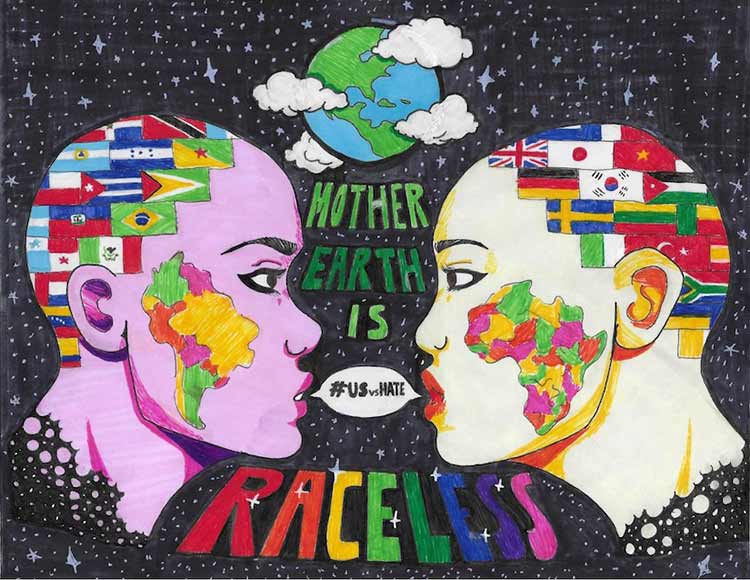
#USvsHate spring 2019 youth vote winner for poster, by Alexis, Grade 12, San Diego.
Homegrown Campaign to Combat Hate on National Stage
It’s a simple premise with a powerful effect: Help young people use their voices to speak up for justice and equity—then amplify the messages they make. That’s the basic M.O. of #USvsHate, a messaging project germinated at UC San Diego and grown in local schools, now branching out nationally as part of Teaching Tolerance, a program of the nonprofit Southern Poverty Law Center dedicated to anti-bias education.
“While adults sometimes get tied in knots over complicated issues, youth can successfully cut to the core. They cut to the chase,” says Mica Pollock, a professor of education studies at UC San Diego and director of the university’s educational research and outreach center called CREATE, who initially conceived #USvsHate in 2017.
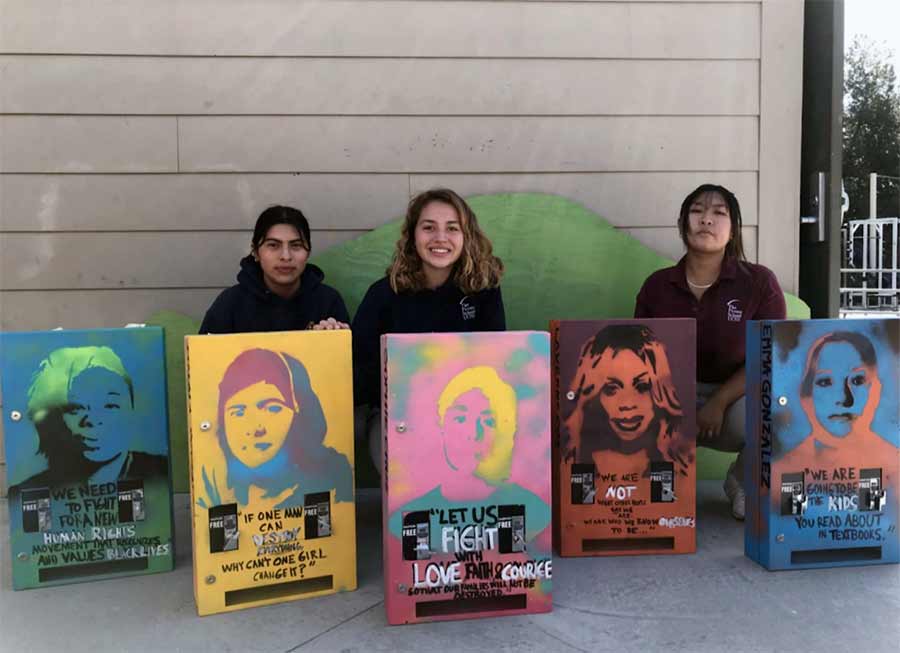
Bao, Stefani and Katie, Grade 10, San Diego, won the spring 2019 youth vote for art installation. The work features five inspirational women under 30 on dispensers of free feminine hygiene products. The dispensers were sent to the school by bill AB-10, which requires Title I schools to provide these products free and which teacher Tamima Noorzay describes as “a recognition of female human rights.”
“Everyone belongs.” “Being Mexican isn’t a crime.” “My body is beautiful.” These are just three of the hundreds of messages that youth have made so far through the #USvsHate project. All three have been turned into stickers. There are also posters—and essays, poems, videos, art installations and songs. The messages—which address all forms of hate on the minds of youth, from racial slurs to shaming someone for their religion or their body shape—live on the #USvsHate website and are shared through social media. They have a physical home in participating schools. And critically, they all represent the product of candid and sometimes difficult conversations in classrooms.
Why? And why now? Hate has been on the rise of late. The FBI has documented an increase in hate crimes over the past few years, and a recent analysis by the Center for the Study of Hate and Extremism comes to a similar grim conclusion. Schools have not been immune; the numbers of hate incidents at schools are also growing.
#USvsHate is one answer to that troubling rise.
Pollock first became deeply concerned by what she was seeing and hearing during the divisive presidential election of 2016. Students and teachers were noticing an increase in hate, she said. Hateful speech and hateful acts—drawings of swastikas, chants of “build that wall”—were making more frequent appearances in classrooms and on playgrounds.
“I couldn’t sit idly by,” Pollock said, “while so many young people were feeling harmed and harassed and endangered at schools.”
Not long after the “full-on, torch-lit march” by white supremacists in Charlottesville, Pollock decided to act, to “stand up for some basic principles of how to treat one another.”
#USvsHate was launched as a small pilot in 2017. While it was Pollock’s brainchild, the campaign was developed collaboratively with Education Studies doctoral student Mariko Cavey, CREATE digital specialist Minhtuyen Mai, and educators throughout San Diego.
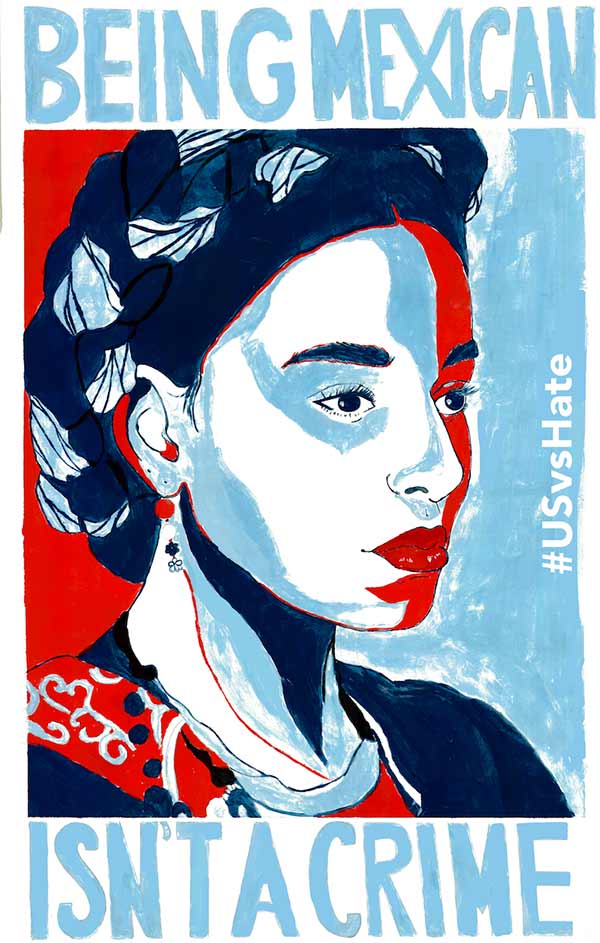
“Being Mexican isn’t a crime,” by a Chula Vista 10th grader named Kayla, was one of the earliest winners of the #USvsHate messaging contests and has proven to be one of the most popular posters and stickers to date.
The team reached out to about 20 different national organizations—ranging from the Anti-Defamation League to the Human Rights Campaign’s Welcoming Schools to the New York Times Learning Network—and asked them to share one or more of their lessons for “refusing hate.”
“Hate” is defined by #USvsHate as “any time people denigrate, disrespect or harm an individual or group as if their identity makes them an inferior or less valuable type of person.”
After gathering the lessons, the #USvsHate team then assembled them into two “buckets”: One category covers inclusion broadly, which may be most appropriate for younger students or those that are still getting to know each other. The second category of lessons deals with more specific forms of hate, bias and inequality. This is one of the distinguishing features of #USvsHate.
“#USvsHate is different from typical ‘be nice’ or anti-bullying initiatives,” Pollock said, “because it tackles racism, xenophobia, homophobia, antisemitism, Islamophobia, sexism and other forms of hate directly instead of putting these all under the be-nice umbrella.”
It’s also distinguished, she said, by its main mechanism of “unleashing student voice.”
How it works: Teachers first consider what is most appropriate for their classrooms and most needed in their communities. In some areas, LGBT kids are feeling particularly vulnerable. In others, immigration is the flash point. It’s up to the teacher to decide both what is necessary and what they’re comfortable tackling. Teachers choose either a couple of lessons or a whole suite, incorporating and adapting them to existing curricula. At the end of the lessons, student create their anti-hate messages and share them out, including via teacher submission to a contest, which is judged by #USvsHate staff as well as by other students. At the end of the day, some of the winning visual messages are made manifest as stickers and posters and sent back to participating schools. Others become performances or shares on social media.
“It’s important to see these messages in person or on a wall,” Pollock said, “but in our digital world, seeing messages you can scroll past is important too.”
Mrs. Mendez's 4th graders at Harbison Elementary in National City made an #USvsHate video urging us to show empathy, take responsibility and avoid giving power to negative words.
The reach of #USvsHate was substantially expanded in the 2018-19 school year, in part through the efforts of CREATE affiliates Kim Douillard and Sarah Peterson.
Peterson leads the California Reading and Literature Project out of CREATE. Douillard is the regional director for the San Diego Area Writing Project in CREATE. Both women are charged with professional development of teachers and work with scores of “teacher-leaders,” who became the first adopters and champions of #USvsHate.
Peterson has known for a long time, she said, that many teachers want to include discussions of identity in their classrooms and provide opportunities for social-emotional learning. But it’s been gratifying to see just how much of an impact #USvsHate has had. “We’re unleashing the social justice-warrior aspect of teachers, too” she said. “Thanks to this project, we’re at the frontier of what’s possible in public schools.”
By the spring of 2019, #USvsHate had engaged more than 50 teachers and more than 3,000 students in the San Diego region, from Chula Vista to Carlsbad.
Student participants have ranged from pre-K through community college, and so the messages run the span, from poignantly simple stick drawings to bold, bright and provocative collage, from statements three words long to sophisticated essays.
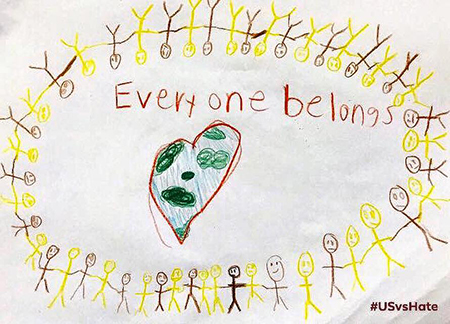
“Everyone belongs,” by Cardiff 3rd grader Aspen, is direct – and was also the director’s choice for sticker in the fall 2018 #USvsHate contest.
Artemisa Perucho-Green teaches first grade in a Title 1 school in Poway, and has a dual-language, Spanish-English classroom. Her 6- and 7-year-old students made a short video. They wrote the script based on some of what they’d experienced at school and then acted out the scenes with Lego figures and other toys brought from home, adding in “upstander endings.” The video was one of the winning messages of the winter 2019 contest.
“I wanted to empower my students,” Perucho-Green said, “not only to identify instances of hate but also to have something to do when they happen. What can you do when someone calls your friend ‘fat’ and is laughing at them? What about if someone says your friend speaks funny?
“I want my students to not just rely on adults swooping in to save the day but to have the tools themselves to change outcomes,” she said. “The kids know so much more than we give them credit for. They have so much empathy.”
Douillard—who in addition to directing the writing project out of CREATE is also a classroom teacher—agrees that both empathy and empowerment are key. She has a third-grade class in Cardiff. Her students are relatively affluent and the majority are white.
“Social justice work should not be limited to, or on the shoulders of, the victims of oppression. Suburban kids, white kids, kids who don’t really know there are inequities need to be involved, too,” Douillard said. It’s also good for them to learn, she said, that “they have words, they have images, they have something they can do and don’t need adults to do it for them.”
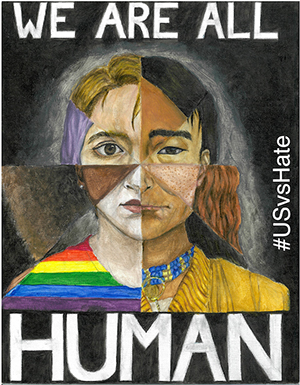
This work by Sky, Grade 10, Chula Vista, was chosen by youth as a spring 2019 winner of #USvsHate and is now a poster on the walls of participating schools across the region.
Douilllard’s students participated in #USvsHate throughout the 2018-19 year. It was eye-opening to her to realize the power not only of the lessons but the contests themselves.
All participating students get to see and vote on the finalist messages. Being exposed to work from throughout the county and from lots of different grades, Douillard said, “really broadened my students’ scope.”
The scope for #USvsHate itself is about to get much larger. Teaching Tolerance reaches about 500,000 educators throughout the country with their materials, Pollock said, and the current plan is to hold a nationwide contest in 2020.
Based on what she’s seen in San Diego, and in the online Schooltalking communities she hosts, she’s fairly confident there will be a lot of uptake.
“Teachers are hungry for tools to make their environments in school more inclusive,” Pollock said. “And kids are eager to speak out on the real-world issues they’re living.” She can’t wait to see what new messages will be created to insist, publicly, that all people are equally valuable.
Share This:
You May Also Like
Stay in the Know
Keep up with all the latest from UC San Diego. Subscribe to the newsletter today.



